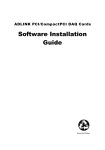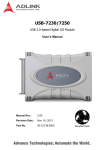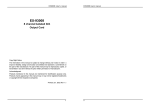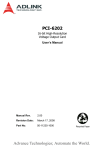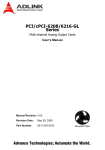Download ADLINK Technology NuDAQ-2500 Series User`s guide
Transcript
NuDAQ PCI-6308 Series Isolated Analog Output Board User's Guide Recycled Paper Copyright 1999~2002 ADLINK Technology Inc. All Rights Reserved. Manual Rev. 1.21: September 11, 2001 Part No. 50-11101-101 The information in this document is subject to change without prior notice in order to improve reliability, design and function and does not represent a commitment on the part of the manufacturer. In no event will the manufacturer be liable for direct, indirect, special, incidental, or consequential damages arising out of the use or inability to use the product or documentation, even if advised of the possibility of such damages. This document contains proprietary information protected by copyright. All rights are reserved. No part of this manual may be reproduced by any mechanical, electronic, or other means in any form without prior written permission of the manufacturer. Trademarks NuDAQ, DAQBench are registered trademarks of ADLINK Technology Inc. Other product names mentioned herein are used for identification purposes only and may be trademarks and/or registered trademarks of their respective companies. Getting service from ADLINK l Customer Satisfaction is the most important priority for ADLINK Tech Inc. If you need any help or service, please contact us. ADLINK Technology Inc. Web Site http://www.adlinktech.com Sales & Service [email protected] NuDAQ + USBDAQ [email protected] Technical Automation [email protected] Support NuIPC [email protected] NuPRO / EBC [email protected] TEL +886-2-82265877 FAX Address 9F, No. 166, Jian Yi Road, Chungho City, Taipei, 235 Taiwan. l +886-2-82265717 Please email or FAX us of your detailed information for a prompt, satisfactory and constant service. Detailed Company Information Company/Organization Contact Person E-mail Address Address Country TEL FAX Web Site Questions Product Model Environment to Use Detail Description Suggestions to ADLINK OS: Computer Brand: M/B: CPU: Chipset: BIOS: Video Card: Network Interface Card: Other: Table of Contents Introduction ................................................................... 1 1.1 1.2 1.3 1.4 Features ................................................................................ 2 Applications ........................................................................... 2 Specifications ........................................................................ 3 Software Supporting.............................................................. 6 1.4.1 Programming Library................................................... 6 ® 1.4.2 PCIS-LVIEW: LabVIEW Driver.................................. 7 1.4.3 PCIS-VEE: HP-VEE Driver.......................................... 7 TM 1.4.4 DAQBench : ActiveX Controls .................................. 7 TM 1.4.5 DASYLab PRO ........................................................ 7 TM 1.4.6 PCIS-DDE: DDE Server and InTouch .................... 7 TM 1.4.7 PCIS-ISG: ISaGRAF driver...................................... 7 TM 1.4.8 PCIS-ICL: InControl Driver....................................... 8 1.4.9 PCIS-OPC: OPC Server.............................................. 8 Installation ..................................................................... 9 2.1 2.2 2.3 2.4 2.5 2.6 2.7 2.8 What You Have ..................................................................... 9 Unpacking ........................................................................... 10 PCI-6308V Layout............................................................... 11 Hardware Installation Outline .............................................. 12 2.4.1 Hardware configuration ............................................. 12 2.4.2 PCI slot selection....................................................... 12 2.4.3 Installation Procedures.............................................. 12 Device Installation for Windows Systems ........................... 13 Connector Pin Assignment ................................................. 13 Jumper Setting ................................................................... 15 Termination Board Connection ........................................... 16 Registers...................................................................... 17 3.1 3.2 3.3 3.4 3.5 PCI PnP Registers .............................................................. 17 I/O Address Map ................................................................. 18 DA Output Register ............................................................. 18 Digital Output Register ........................................................ 19 Digital Input Ports................................................................ 19 Table of Contents • i Operation Theory ........................................................ 20 4.1 4.2 4.3 4.4 4.5 Voltage Output .................................................................... 20 4.1.1 Voltage Output Range Selection............................... 20 4.1.2 DA data format .......................................................... 21 Analog Output Status Register ........................................... 22 Current Output and Range Control ..................................... 22 Isolated Digital Output......................................................... 23 Isolated Digital Input............................................................ 23 C/C++ Library............................................................... 24 5.1 5.2 Libraries Installation ........................................................... 24 Programming Guide ............................................................ 25 5.2.1 Naming Convention................................................... 25 5.2.2 Data Types ................................................................ 25 5.3 _6308_Initial....................................................................... 26 5.4 _6308_Software_Reset....................................................... 26 5.5 _6308_DA .......................................................................... 27 5.6 _6308_DA_0_3 .................................................................. 28 5.7 _6308_DA_4_7 .................................................................. 29 5.8 _6308_Get_DA_Status ...................................................... 30 5.9 _6308_DI............................................................................ 31 5.10 _6308_DO .......................................................................... 32 5.11 _6308_I2V_Control ............................................................ 33 Warranty Policy ........................................................... 34 ii • Table of Contents How to Use This Guide This manual is designed to help you use the PCI-6308. It describes how to configure and control various functions of the PCI-6308 card. It is divided into six chapters: Chapter 1, “Introduction”, gives an overview of the product features, applications, and specifications. Chapter 2, “Installation”, describes how to install the PCI-6308. The layout of the PCI-6308 is shown, as well as connector specifications, and installation notes are described. Chapter 3, “Registers”, describes the details of the registers and its structure. This information is important for programmers who want to control the hardware with low-level programming Chapter 4, “Operation Theory”, describes the working theory of the PCI-6308 series card. The DIO and DA systems are introduced. Chapter 5, “C/C++ Library”, describes the functions in the DOS C/C++ Library and Windows 95 DLL. Chapter 6, “Software Utility”, describes how to run the utility program included in the software CD. How to Use this Guide • iii 1 Introduction The PCI-6308 series products are isolated analog output cards. The PCI6308 series includes the follow three cards: l PCI-6308V: Isolated 8-CH voltage output card l PCI-6308A: Isolated 8-CH voltage and current output card l PCI-6304V: Isolated 4-CH voltage output card The PCI-6308V is a high-performance, 12-bit analog output board with PCI interface. The PCI-6308V provide 8 identical voltage output channels, with each channel capable of: (1) bipolar ±10V voltage outputs; (2) unipolar 0~+10V voltage output; and (3) unipolar 0 to user defined voltage output. The DA chip used is the DAC-4814AP. A state-of-the-art, fully monotonic, digital to analog converter. This device employs ultra-stable nichrome (NiCr) thin-film resistors to provide monotonicity, low distortion, and low differential linearity error over long periods of time. The PCI-6304V is available to large quantity OEM only. It is fully compatible with the PCI-6308V, but has four voltage-output channels only. Its functionality, supported software and operation performance is identical to that of the PCI-6308V, Hence no further reference to the PCI-6308 is outline in this manual. The PCI-6308A is the combination of the PCI-6308V with an 8-CH current output extended board modeled EXP-8A. The EXP-8A board includes 8 precision voltage-to-current converters/transmitters, which converts voltage output of PCI-6308V to a current source output. The EXP-8A is piggybacked onto the PCI-6308V. Therefore, the PCI-6308A provides both voltage and current outputs. The total number of analog output channel is still 8. Introduction • 1 1.1 Features • 32-bit PCI-Bus, Plug and Play, complies with PCI local bus specification Rev 2.1 • 8-CH 12-bit voltage output • Fully isolation protection from PC power to external device • 2500Vrms isolation voltage • Unipolar or bipolar voltage output range • Current output available on PCI-6308A, • On board DC-to-DC converter provide voltage and current source • 4 Isolated digital input channels • 4 Isolated digital output channels 1.2 Applications • Industrial Process Control • Pressure / Temperature Transmitter • Current Source for Testing Equipment • Servo Control 2 • Introduction 1.3 Specifications u Voltage Output • Numbers of channel: 8 channel for PCI-6308V and PCI- 6308A • Converter: DAC4814AP or equivalent • Conversion type: Monolithic multiplying • Resolution: 12-bit no missing code (11-bit guarantee) • Voltage output range: (jumper selectable) P P P Bipolar: ±10V Unipolar: 0~10V User defined unipolar: 0~ user defined voltage. • Voltage output driving capability: ± 5mA min. • Settling time: 16 µ second (-10V to +10V) • DA update time: 90 µ second for four channels simultaneously • Gain error: ± 0.2 % (max, without trimming, with internal 10.0V reference voltage) • Differential Linearity Error: ± 0.002 % Full Scale Range • Data Transfer: Programmed I/O • Isolation voltage: 2500Vrms (photo isolation PC410) • Output initial status: 0V (after RESET or POWER-ON) Introduction • 3 u u Current Output • Numbers of channel: 8 channel for PCI- 6308A • Current output range: 0~20mA, 4~20mA, 5~25mA. (Software programmable) • Voltage to current converter: B.B. XTR110 or equivalent • Settling time: 17 µ second (0~20mA) • Slew rate: 1.3mA / µs • Non-linearity: ± 0.01 % of Span • Span error: 0.3% of initial Span • Output resistance: 10 Ohms maximum • Output initial status: 0mA (after RESET or POWER-ON) Digital Input • Numbers of digital input channel: 4 isolated input channel • Photo isolator: PC3H4 or equivalent • Isolation voltage: 2500Vrms • Input voltage: up to 34Vdc P P • u Logic "L": 0~3.0V Logic "H": 3.2~34V Input resistance: 2.4KΩ @ 0.5W Digital Output • Numbers of digital output channel: 4 isolated output channel • Photo isolator: PC3H7 or equivalent • Isolation voltage: 2500Vrms • Output type: Photo-coupler transistors, open collector up to 35Vdc • Sink current: 50mA maximum 4 • Introduction u Power Supply source • +15V output (Pin #7 on CN1): P P • -15V output (Pin #25 on CN1): P P u 200mA maximum (for PCI-6308V) 20mA maximum (for PCI-6308A, when all current output channel is 25mA) 200mA maximum (for PCI-6308V) 20mA maximum (for PCI-6308A, when all current output channel is 25mA) General Specifications • Operating temperature: 0° ~ 55°C • Storage temperature: -20° ~ 80°C • Humidity: 5 ~95% non-condensing • Connector: 37-pin D-sub connector (female) • Bus interface: 32-bit slave PCI bus • Power consumption: P PCI-6308V: +5VDC @ 220mA typical +12VDC @ 175mA typical P PCI-6308A: +5VDC @ 220mA typical +12VDC @ 250mA typical Or +12VDC @ 530mA (when all current output channels are 25mA) • PCB Dimension: Half-sized 172 mm x 105 mm Introduction • 5 1.4 Software Supporting ADLINK provides versatile software drivers and packages for users’ different approach to building a system. We not only provide programming libraries such as DLL for many Windows systems, but also provide drivers for many ® TM TM TM software package such as LabVIEW , HP VEE , DASYLab , InTouch , TM TM InControl , ISaGRAF , and so on. All software options are included in the ADLINK CD. Non-free software drivers are protected with licensing codes. Without the software code, you can install and run the demo version for two hours for trial/demonstration purposes. Please contact ADLINK dealers to purchase the formal license. 1.4.1 Programming Library For customers who are writing their own programs, we provide function libraries for many different operating systems, including: • DOS Library: Borland C/C++ and Microsoft C++, the functions descriptions are included in this user’s guide. • Windows 95 DLL: For VB, VC++, Delphi, BC5, the functions descriptions are included in this user’s guide. • PCIS-DASK: Include device drivers and DLL for Windows 98, Windows NT and Windows 2000. DLL is binary compatible across Windows 98, Windows NT and Windows 2000. That means all applications developed with PCIS-DASK are compatible across Windows 98, Windows NT and Windows 2000. The developing environment can be VB, VC++, Delphi, BC5, or any Windows programming language that allows calls to a DLL. The user’s guide and function reference manual of PCIS-DASK are in the CD. Please refer the PDF manual files under \\Manual_PDF\Software\PCISDASK • PCIS-DASK/X: Includes device drivers and shared library for Linux. The developing environment can be Gnu C/C++ or any programming language that allows linking to a shared library. The user's guide and function reference manual of PCIS-DASK/X are in the CD. (\Manual_PDF\Software\PCIS-DASK-X.) The above software drivers are shipped with the board. Please refer to the “Software Installation Guide” for installation procedures. 6 • Introduction 1.4.2 ® PCIS-LVIEW: LabVIEW Driver PCIS-LVIEW contains the VIs, which are used to interface with NI’s LabVIEW® software package. The PCIS-LVIEW supports Windows 95/98/NT/2000. The LabVIEW® drivers is shipped free with the board. You can install and use them without a license. For more information about PCIS-LVIEW, please refer to the user’s guide in the CD. (\\Manual_PDF\Software\PCIS-LVIEW) 1.4.3 PCIS-VEE: HP-VEE Driver The PCIS-VEE includes user objects, which are used to interface with the HP VEE software package. PCIS-VEE supports Windows 95/98/NT. The HPVEE drivers are shipped free with the board. For more information about PCIS-VEE, please refer to the user’s guide in the CD. (\\Manual_PDF\Software\PCIS-VEE) 1.4.4 TM DAQBench : ActiveX Controls We suggest customers who are familiar with ActiveX controls and VB/VC++ programming use the DAQBenchTM ActiveX Control component library for developing applications. The DAQBenchTM is designed under Windows NT/98. For more information about DAQBench, please refer to the user’s guide in the CD. (\\Manual_PDF\Software\DAQBench\ DAQBench Manual.PDF). 1.4.5 TM DASYLab PRO DASYLab is an easy-to-use software package, which provides easy-setup instrument functions such as FFT analysis. Please contact ADLINK to obtain DASYLab PRO, which includes DASYLab and ADLINK hardware drivers. 1.4.6 PCIS-DDE: DDE Server and InTouch TM DDE stands for Dynamic Data Exchange. The PCIS-DDE includes the PCI cards’ DDE server. The PCIS-DDE server is included in the ADLINK CD. It needs a license. The DDE server can be used in conjunction with any DDE client under Windows NT. 1.4.7 PCIS-ISG: ISaGRAF TM driver The ISaGRAF WorkBench is an IEC1131-3 SoftPLC control program development environment. The PCIS-ISG includes ADLINK product drivers for ISaGRAF under Windows NT environment. The PCIS-ISG is included in the ADLINK CD. A license is needed to use the drivers. Introduction • 7 1.4.8 PCIS-ICL: InControl TM Driver PCIS-ICL is the InControl driver, which supports Windows NT. The PCIS-ICL is included in the ADLINK CD. A license is needed to use the drivers. 1.4.9 PCIS-OPC: OPC Server PCIS-OPC is an OPC Server, which can link with OPC clients. There are several software packages on the market, which can provide the OPC clients. The PCIS-OPC supports Windows NT and requires a license to operate. 8 • Introduction 2 Installation This chapter describes how to install the PCI-6308. Please follow the following steps to install the PCI-6308 family of products. • Check what you have (section 2.1) • Unpacking (section 2.2) • Check the PCB and jumper location (section 2.3) • Install the hardware and setup and jumpers (section 2.4, 2.7) • Install the software drivers and run utility to test (section 2.5) • Cabling with external devices (section 2.6, 2.8) 2.1 What You Have In addition to this User's Manual, the package includes the following items: • PCI-6308V (or PCI-6308A) Board • ADLINK CD • Software Installation Guide If any of these items are missing or damaged, contact ADLINK or the dealer from whom you purchased the product. Save the shipping materials and carton in case you want to ship or store the product in the future. Installation • 9 2.2 Unpacking The PCI-6308 series card contains electro-static sensitive components that can be easily be damaged by static electricity. Therefore, the card should be handled on a grounded anti-static mat. The operator should be wearing an anti-static wristband, grounded at the same point as the anti-static mat. Inspect the card module carton for obvious damages. Shipping and handling may cause damage to your module. Be sure there are no shipping and handling damages on the modules carton before continuing. After opening the card module carton, extract the system module and place it only on a grounded anti-static surface with component side up. Again, inspect the module for damages. Press down on all the socketed IC's to make sure that they are properly seated. Do this only with the module place on a firm flat surface Note: DO NOT APPLY POWER TO THE CARD IF IT HAS BEEN DAMAGED. You are now ready to install your PCI-6308 series card. 10 • Installation 2.3 PCI-6308V Layout Figure 2.1 PCI-6308V Layout Installation • 11 2.4 Hardware Installation Outline 2.4.1 Hardware configuration The PCI cards (or CompactPCI cards) are equipped with plug and play PCI controllers, it can request base addresses and interrupts according to the PCI standard. The system BIOS will assign the system resources based on the PCI cards’ configuration registers and system parameters (which are set by the system BIOS). Interrupt assignment and memory usage (I/O port locations) can only be assigned by the system BIOS. These system resource assignments are done on a board-by-board basis. It is not suggested to assign the system resource by any other methods. 2.4.2 PCI slot selection The PCI card can be inserted into any PCI slot without any configuration of the system resources. The CompactPCI card can also be inserted into any CompactPCI I/O slot. 2.4.3 Installation Procedures 1. Turn off your computer 2. Turn off all accessories (printer, modem, monitor, etc.) connected to your computer. 3. Remove the cover from your computer. 4. Setup jumpers on the PCI or CompactPCI card. 5. Select a 32-bit PCI slot. PCI slot are shorter than ISA or EISA slots, and are usually white or ivory. 6. Before handling the PCI cards, discharge any static buildup on your body by touching the metal case of the computer. Hold the edge and do not touch the components. 7. 8. Position the board into the PCI slot you selected. Secure the card in place at the rear panel of the system. 12 • Installation 2.5 Device Installation for Windows Systems Once Windows 95/98/2000 has started, the Plug and Play functions of the Windows system will find and locate the new NuDAQ/NuIPC card. If this is the first time a NuDAQ/NuIPC card is installed in your Windows system, you will be prompted to input the device information source. Please refer to the “Software Installation Guide” for installation procedures of the device drivers. 2.6 Connector Pin Assignment The pin assignment of PCI-6308V/6308A/6304V are shown in Figure 2.2 DI3 (1) DI2 (2) DI1 (3) DI0 (4) DIGND (5) ExtVref (6) +15V (7) A.GND (8) (A6) (9) V6 (10) A.GND (11) (A4) (12) V4 (13) A.GND (14) (A2) (15) V2 (16) A.GND (17) (A0) (18) V0 (19) (20) DO3 (21) DO2 (22) DO1 (23) DO0 (24) DOGND (25) -15V (26) A.GND (27) (A7) (28) V7 (29) A.GND (30) (A5) (31) V5 (32) A.GND (33) (A3) (34) V3 (35) A.GND (36) (A1) (37) V1 Figure 2.2Pin Assignment of CN1 connector Installation • 13 Legend: Vn: ExtVref: the voltage output of channel n for PCI-6308V/6308A, n=0~7 for PCI-6304V, n=0~4 the current output of channel n An is used by the PCI-6308A only, n=0~7 external reference voltage for voltage output AGND: Ground of analog output channels and +/-15V -15V: -15V voltage output +15V: +15V voltage output DIx: Digital input channel x DOx: Digital Output channel x DIGND: Isolated ground of digital input DOGND: Isolated ground of digital output An: 14 • Installation 2.7 Jumper Setting The PCI-6308‘s voltage output channels can be configured with different voltage range. Each output channel and its corresponding jumpers are listed below. Channel NO. CH0 CH1 CH2 CH3 CH4 CH5 CH6 CH7 Corresponding Jumper For output mode (Unipolar/Bipolar) JP1 JP9 JP2 JP9 JP3 JP9 JP4 JP9 JP5 JP10 JP6 JP10 JP7 JP10 JP8 JP10 Corresponding Jumper For reference voltage sources (external/internal) JP11 JP11 JP11 JP11 JP12 JP12 JP12 JP12 The output range is dependent on the D/A converter's reference voltage source and output mode (Bipolar or Unipolar). JP11 and JP12 are used for setting reference voltage sources either internal or external. External reference voltage input (ExtVref) is located on connector CN1. JP1~8 and JP9/10 are used to set the output mode to be unipolar or bipolar. Output Range Unipolar/Bipolar JP1~JP8 JP9~JP10 external/internal JP11~JP12 -10V to +10V Bipolar (Default) 1 2 3 1 2 3 1 2 3 0V to +10V Unipolar 1 2 3 1 2 3 1 2 3 0V to ExtRef Voltage Unipolar 1 2 3 1 2 3 1 2 3 Installation • 15 2.8 Termination Board Connection The PCI-6308 is equipped with a DB-37 connector. termination boards include: The available • ACLD-9137: A general purposed 37-pin screw terminal. The ACLD9137 has a DB-37 male connector, which is used to directly attach to the PCI-6308. • ACLD-9188: A general purposed 37-pin screw terminal, which is equipped with a heavy-duty screw terminal • DIN-37D: A general purposed 37-pin screw terminal with a DINsocket, which provides for easily installation. DIN-37D is shipped with a 37-pin cable. 16 • Installation 3 Registers The descriptions of the registers and structure of the PCI-6308 Series are outlined in this chapter. The information in this chapter will assist programmers, who wish to handle the card with low-level programs. In addition, the low level programming syntax is introduced. This information can help beginners to operate the 743X in the shortest possible time. 3.1 PCI PnP Registers This PCI card functions as a 32-bit PCI target device to any master on the PCI bus. There are three types of registers: PCI Configuration Registers (PCR), Local Configuration Registers (LCR) and PCI-6308 registers. The PCR, which is PCI-bus specifications compliant, is initialized and controlled by the plug & play (PnP) PCI BIOS. Users may obtain more information on the PCI BIOS specification to better understand the operation of the PCR. Please contact PCISIG to acquire the specifications of the PCI interface. The PCI bus controller PCI-9050 is provided by PLX technology Inc. (www.plxtech.com). For more information about the LCR, please visit PLX technology’s web site to download relative information. It is not necessary for users to fully understand the details of the LCR if the software library provided is used. The PCI PnP BIOS assigns the base address of the LCR. The assigned address is located at an offset of 14h from the PCR. The PCI-6308 registers are discussed in the next section. The base address, which is also assigned by the PCI PnP BIOS, is located at an offset of 18h from the PCR. Therefore, users can read the address 18h from the PCR to obtain its base address by using the BIOS function call. Do not attempt to modify the base address and interrupt that have been assigned by the PCI PnP BIOS, it may cause resource conflicts with your system. Registers • 17 3.2 I/O Address Map Most of the PCI-6308 registers are 16 bits. Users can access these registers using 16-bit I/O instructions. The following table shows the registers map, including descriptions and their offset addresses relative to the base address. I/O Address Base + 00h Base + 02h Base + 04h Base + 06h Base + 08h Base + 0Ah Base + 0Ch Base + 0Eh Base + 10h ~3Eh Base + 40h Write Read DA Channel #3 value DA Sent Status DA Channel #2 value -DA Channel #1 value -DA Channel #0 value -DA Channel #7 value -DA Channel #6 value -DA Channel #5 value -DA Channel #4 value -Reserved Digital Input Digital Output Table 3.1 I/O Address Map 3.3 DA Output Register There are 8 analog output channels on the PCI-6308. Every channel is 12bits. Address: BASE + 00(hex) ~ BASE+ 0E(hex) Attribute: write only Data Format: Bit BASE+0 Bit BASE+1 18 • Registers 7 DA7 15 -- 6 DA6 14 -- 5 DA5 13 -- 4 DA4 12 -- 3 DA3 11 DA11 2 DA2 10 DA10 1 DA1 9 DA9 0 DA0 8 DA8 3.4 Digital Output Register D0~D3 is the digital output signal written to the output channel. D4~D7 don’t care. Address: BASE + 40(hex) Attribute: write only Data Format: Bit BASE+20 7 X 6 X 5 X 4 X 3 DO3 2 DO2 1 DO1 0 DO0 1 DO1 0 DO0 3.5 Digital Input Ports D4~D7 is the digital input signal from CN1. D0~D3 is read back signal from the digital output channel. Address: BASE + 40(hex) Attribute: read only Data Format: Bit BASE+20 7 DI3 6 DI2 5 DI1 4 DI0 3 DO3 2 DO2 Registers • 19 4 Operation Theory In this chapter, the detail operation theory of the PCI-6308V and PCI-6308A is described. Before programming or applying the PCI-6308 card to your application, please go through this chapter to understand the features first. 4.1 Voltage Output There are 8 voltage output channels for PCI-6308V and 6308A. For voltage output operation, you have to understand: 1. 2. 4.1.1 How to set the voltage output range. The DA data format. Voltage Output Range Selection The DA converters of the PCI-6308 are Burr-Brown DAC4814AP. The DAC has a 12-bit resolution with bipolar or unipolar output. The voltage output range is set by JP1~JP8. Please refer to section 2.7 for detail of the jumper settings. The selectable range is +/-10V, 0~+10V and 0V ~ user defined voltage. User-defined voltage is inputted from the DB-37 connector at pin #6. 20 • Operation Theory 4.1.2 DA data format The DA data format is a 12-bit unsigned value for all channels, that is, the value is in binary format. The digital value range from 0(0X000) to +4095(0xFFF) corresponds to the full span of the output range, which is set by the jumpers. Table 4.1 shows the relationship between the digital value and the analog output voltage. If the application requires a smaller voltage range, the PCI-6308 can still be applied. For example, if the application voltage range is uni-polar between 0~5V, user need only set jumper to external reference mode, and supply a 5V source to pin 6 of CN1. For +/-10V mode: Digital Value 4095 2048 0 HEX value 0xFFF 0x800 0x000 Output Voltage +9.99969V 0.00000V -10.00000V HEX value 0xFFF 0x800 0x000 Output Voltage +9.99969V 5.00000V 0.00000V HEX value 0xFFF 0x800 0x000 Output Voltage +Vuser +Vuser/2 0.00000V For 0~+10V mode: Digital Value 4095 2048 0 For 0V ~ Vuser mode: Digital Value 4095 2048 0 Table 4.1 DA Voltage Output Format The above table shows the address of every analog output ports relative to the base address. Note that the base address is assigned by the PCI BIOS. The current output control of the PCI-6308A is described in Section 4.3. Operation Theory • 21 4.2 Analog Output Status Register The DAC uses a series bus architecture hence there is a delay in the output of the digital value. The data transfer time for every DA data write takes 16µs, therefore the software driver must wait for 16µs before sending another set of data to any analog output port. While the DA value is sending, the Data_Send bit is ‘H’. The software driver should check this bit before writing any data to the output port. This register is read only. Base 0x00 D16~D1 X D0 Data_Send 4.3 Current Output and Range Control A precision voltage-to-current converter XTR110 implements the current output. The current output channel n (An) is control by the voltage of channel n (Vn). A block diagram of the current output channels is shown in Fig 4.1. O n B o a rd + 1 5 V XTR110 50 Ohm Vn An Io C u rre n t O u tp u t R a n g e C o n tro l External Load ( R e s is t e r R L = 2 5 0 O h m t y p ic a l) A .G N D Figure 4.1 Current output circuit The PCI-6308A provides an on board +15V power supply. Each current output channel is a current source, which is controlled by the voltage of the corresponding voltage output channel. For example, voltage output channel 3 control the current source of channel 3. The output current range is programmable. The current range control register controls all 8 current channels on the PCI-6308A. There are three kinds of output current ranges. Refer to the following table and Section 5.2.9 for programming the current range using the _6308_I2V_Control function. 22 • Operation Theory Mode 0 1 2 3 Input Voltage Range 0~10V 0~10V -0~10V Output Current Range 0~20 mA 5~25 mA -4~20 mA 4.4 Isolated Digital Output The isolated digital output circuits have the following characteristics. The output is of an open collector type. The isolation voltage between the isolated output and the host power signals is 2500 Vrms. Don (n=1~4) Photo Coupler GND 4.5 Isolated Digital Input The isolated digital input circuits have the following characteristics. The input is equipped with a current-limit resistor. The input voltage can be up to 34V. The isolation voltage between the isolated input and the host power signals is 2500 Vrms. 2.4KO 1/2W Din (n=1~4) GND Operation Theory • 23 5 C/C++ Library This chapter describes the software library for operating this card. Only the functions in the DOS library and Windows 95 DLL are described. Please refer to the PCIS-DASK function reference manual, which is included in the ADLINK CD, for descriptions of Windows 98/NT/2000 DLL functions. Function prototypes and useful constants are defined in the header files of the LIB directory (DOS) and INCLUDE directory (Windows 95). For Windows 95 DLL, the developing environment can be Visual Basic 4.0 or above, Visual C/C++ 4.0 or above, Borland C++ 5.0 or above, Borland Delphi 2.x (32-bit) or above, or any Windows programming language that allows calls to a DLL. The directory provides C/C++, VB, and Delphi INCLUDE files. 5.1 Libraries Installation Please refer to the “Software Installation Guide” for detail information about how to install the software libraries for DOS, Windows 95 DLL, or PCISDASK for Windows 98/NT/2000. The device drivers and DLL functions for Windows 98/NT/2000 are included with the PCIS-DASK. Please refer to the PCIS-DASK user’s guide and function reference, which is included in the ADLINK CD, for detailed programming information. 24 • C/C++ Library 5.2 Programming Guide 5.2.1 Naming Convention There are 7 function calls provided by the C Language Library. All the functions of the PCI-6308 are covered in this library. The functions of the PCI-6308 software driver use full-names to represent the functions' real meaning. The naming convention rules are: In DOS Environment: _{hardware_model}_{action_name}. e.g. _6308_Initial(). All functions in the PCI-6308 driver start with 6308 as {hardware_model} and can be used by both the PCI-6308V and PCI-6308A. In order to distinguish the difference between DOS library and Windows 95 library, a capital "W" is place on the beginning of each function name of the Windows 95 DLL driver. e.g. W_6308_Initial(). 5.2.2 Data Types We have defined some data type in the Pci_6308.h (DOS) and Acl_pci.h (Windows 95) header files. These data types are used by the PCI-6308/6216 library and suggest you use these data types in your application programs. The following table shows the data type names and their range. Type Name Description Range U8 8-bit ASCII character 0 to 255 I16 16-bit signed integer -32768 to 32767 U16 16-bit unsigned integer 0 to 65535 I32 32-bit signed integer -2147483648 to 2147483647 U32 32-bit single-precision floating-point 0 to 4294967295 F32 32-bit single-precision floating-point -3.402823E38 to 3.402823E38 F64 64-bit double-precision floating-point -1.797683134862315E308 to 1.797683134862315E309 Boolean Boolean logic value TRUE, FALSE C/C++ Library • 25 5.3 _6308_Initial @ Description This function is used to initialize the PCI 6308. Every PCI_6308 has to be initialized by this function before calling other functions. @ Syntax C/C++ (DOS) U16 _6308_Initial (U16 *existCards, PCI_INFO *pciInfo) C/C++ (Windows 95) U16 W_6308_Initial (U16 *existCards, PCI_INFO *pciInfo) Visual Basic (Windows 95) W_6308_Initial (existCards As Integer, pciInfo As PCI_INFO) As Integer @ Argument existCards: number of existing PCI-6308 cards info: relative information of the PCI-6308 cards @ Return Code ERR_NoError ERR_BoardNoInit ERR_PCIBiosNotExist 5.4 _6308_Software_Reset @ Description This function is used to reset the I/O port configuration. Note that this function cannot re-start the PCI bus and all the hardware setting won’t be change either. @ Syntax C/C++ (DOS) void _6308_Software_Reset (U16 cardNo) C/C++ (Windows 95) void W_6308_Software_Reset (U16 cardNo) Visual Basic (Windows 95) W_6308_Software_Reset (ByVal cardNo As Integer) @ Argument cardNo: @ Return Code ERR_NoError 26 • C/C++ Library the card number of PCI-6308 card 5.5 _6308_DA @ Description This function is used to write data to the D/A converters. There are 8 Digital-to-Analog conversion channels on the PCI-6308. The resolution of each channel is 12 bits unsign; i.e. the digital value range from 0 (0x000) to +4095 (0xFFF). Please refer to section 4.1.2 for details of the DA data format. @ Syntax C/C++ (DOS) U16 _6308_DA (U16 cardNo, U16 chn, I16 DAData) C/C++ (Windows 95) U16 W_6308_DA (U16 cardNo, U16 chn, I16 DAData) Visual Basic (Windows 95) W_6308_DA (ByVal cardNo As Integer, ByVal chn As Integer, ByVal DAData As Integer) As Integer @ Argument cardNo: Chn: DAData: The card number of PCI-6308 card D/A channel number D/A data value @ Return Code ERR_NoError C/C++ Library • 27 5.6 _6308_DA_0_3 @Description This function is used to simultaneously write data to the D/A converters of channel 0 to channel 3. The resolution of each channel is 12 bits unsign; i.e. the digital value range from 0 to 4095. Please refer to section 4.1.2 for details of the DA data format. @Syntax c/c++ (DOS) U16 _6308_DA_0_3(U16 cardNo, I16 DA0_Data, I16 DA1_Data, I16 DA2_Data, I16 DA3_Data) c/c++ (Windows 95) U16 W_6308_DA_0_3(U16 cardNo, I16 DA0_Data, I16 DA1_Data, I16 DA2_Data, I16 DA3_Data) Visual Basic (Windows 95) W_6308_DA_0_3(ByVal cardNo As Integer, ByVal DA0_Data As Integer, ByVal DA0_Data As Integer, ByVal DA2_Data As Integer, ByVal DA3_Data As Integer) @Argument cardNo: DA0_Data: DA1_Data: DA2_Data: DA3_Data: @Return Code ERR_NoError 28 • C/C++ Library The card number of Channel 0 D/A data Channel 1 D/A data Channel 2 D/A data Channel 3 D/A data PCI-6308 card value value value value 5.7 _6308_DA_4_7 @Description This function is used to simultaneously write data to the D/A converters of channel 4 to channel 7. The resolution of each channel is 12 bits unsign; i.e. the digital value range from 0 to 4095. Please refer to section 4.1.2 for details of the DA data format. @Syntax c/c++ (DOS) U16 _6308_DA_4_7(U16 cardNo, I16 DA4_Data, I16 DA5_Data, I16 DA6_Data, I16 DA7_Data) c/c++ (Windows 95) U16 W_6308_DA_4_7(U16 cardNo, I16 DA4_Data, I16 DA5_Data, I16 DA6_Data, I16 DA7_Data) Visual Basic (Windows 95) W_6308_DA_4_7(ByVal cardNo As Integer, ByVal DA4_Data As Integer, ByVal DA5_Data As Integer, ByVal DA6_Data As Integer, ByVal DA7_Data As Integer) @Argument cardNo: DA4_Data: DA5_Data: DA6_Data: DA7_Data: The card number of Channel 4 D/A data Channel 5 D/A data Channel 6 D/A data Channel 7 D/A data PCI-6308 card value value value value @Return Code ERR_NoError C/C++ Library • 29 5.8 _6308_Get_DA_Status @ Description This function is used to check the DA data sending status. Because the data transfer time for every DA data takes 16.0 µs, the software driver must wait for 16.0µs before sending another data to any analog output port. This function should be called before writing any data to the output port. While the DA value is sending, the returned value is “1”, otherwise the returned value is “0”. @ Syntax C/C++ (DOS) U16 W_6308_Get_DA_Status (U16 cardNo) C/C++ (Windows 95) U16 W_6308_Get_DA_Status (U16 cardNo) Visual Basic (Windows 95) W_6308_Get_DA_Status (ByVal cardNo Integer As Integer) As @ Argument cardNo: cards The card number of PCI-6308 @ Return Code 0 (low): no DA value is sending 1 (high): the DA value is sending 30 • C/C++ Library 5.9 _6308_DI @ Description This function is used to read data from the digital input ports. There are 4 digital input channels on the PCI-6308. The retrieved value is stored in DIData. @ Syntax C/C++ (DOS) U16 _6308_DI (U16 cardNo, U16 *DIData) C/C++ (Windows 95) U16 W_6308_DI (U16 cardNo, U16 *DIData) Visual Basic (Windows 95) W_6308_DI (ByVal cardNo As Integer, DIData As Integer) As Integer @ Argument cardNo: DIData: the card number of PCI-6308 cards the value read from digital input port @ Return Code ERR_NoError C/C++ Library • 31 5.10 _6308_DO @ Description This function is used to write data to the digital output ports. There are 4 digital output channels on the PCI-6308, i.e. the output value ranges from 0 to 15. @ Syntax C/C++ (DOS) U16 _6308_DO (U16 cardNo, U16 DOData) C/C++ (Windows 95) U16 W_6308_DO (U16 cardNo, U16 DOData) Visual Basic (Windows 95) W_6308_DO (ByVal cardNo As Integer, Integer) As Integer ByVal DOData @ Argument cardNo: DOData: @ Return Code ERR_NoError 32 • C/C++ Library the card number of PCI-6308 cards the value written to digital output port As 5.11 _6308_I2V_Control @ Description This function is used to set the PCI-6308As’ voltage-to-current mode control. There are three range modes for the PCI-6308A. Please refer to section 3.3 for details of the voltage to current conversion. The three voltage-to-current modes are: Mode I_0to20mA I_4to20mA I_5to25mA Input Voltage Range 0~10V 0~10V 0~10V Output Current Range 0~20 mA 4~20 mA 5~25 mA @ Syntax C/C++ (DOS) U16 _6308_I2V_Control (U16 cardNo, U16 ctrl) C/C++ (Windows 95) U16 W_6308_I2V_Control (U16 cardNo, U16 ctrl) Visual Basic (Windows 95) W_6308_I2V_Control (ByVal cardNo As Integer, ByVal ctrl As Integer) As Integer @ Argument cardNo: ctrl: the card number of PCI-6308A cards the voltage-to-current mode, the valid modes are shown in the above table. The constants are defined in Pci_6308.h (DOS) and Acl_pci.h (Windows 95). @ Return Code ERR_NoError C/C++ Library • 33 Warranty Policy Thank you for choosing ADLINK. To understand your rights and enjoy all the after-sales services we offer, please read the following carefully. 1. Before using ADLINK’s products, please read the user manual and follow the instructions exactly. When sending in damaged products for repair, please attach an RMA application form. 2. All ADLINK products come with a two-year guarantee, free of repair charge. l l l 3. The warranty period starts from the product’s shipment date from ADLINK’s factory Peripherals and third-party products not manufactured by ADLINK will be covered by the original manufacturers’ warranty End users requiring maintenance services should contact their local dealers. Local warranty conditions will depend on the local dealers Our repair service does not cover the two-years warranty, while damage goods are cause by the following: a. Damage caused by not following instructions on user menus. b. Damage caused by carelessness on the users’ part during product transportation. c. Damage caused by fire, earthquakes, floods, lightening, pollution and incorrect usage of voltage transformers. d. Damage caused by unsuitable storage environments with high temperatures, high humidity or volatile chemicals. e. Damage caused by leakage of battery fluid when changing batteries. f. Damages from improper repair by unauthorized technicians. g. Products with altered and damaged serial numbers are not entitled to our service. h. Other categories not protected under our guarantees. 34 • Warranty Policy 4. Customers are responsible for the fees regarding transportation of damaged products to our company or to the sales office. 5. To ensure the speed and quality of product repair, please download an RMA application form from our company website www.adlinktech.com. Damaged products with RMA forms attached receive priority. For further questions, please contact our FAE staff. ADLINK: [email protected] Test & Measurement Product Segment: [email protected] Automation Product Segment: [email protected] Computer & Communication Product Segment: [email protected] ; [email protected] Warranty Policy • 35















































